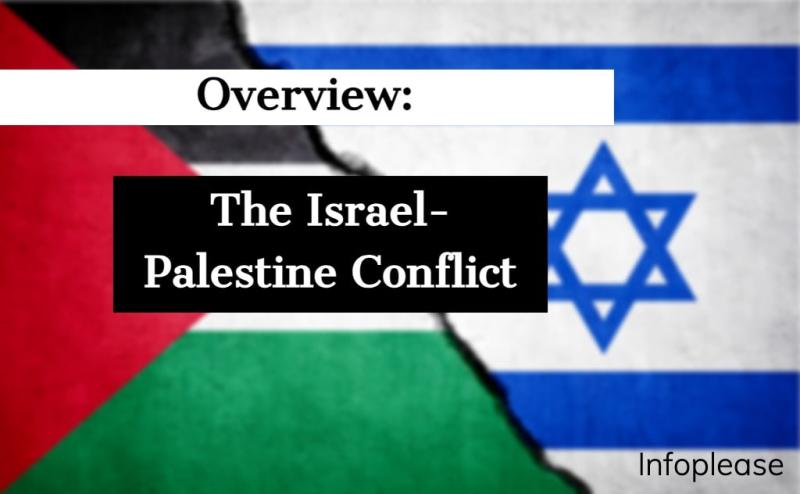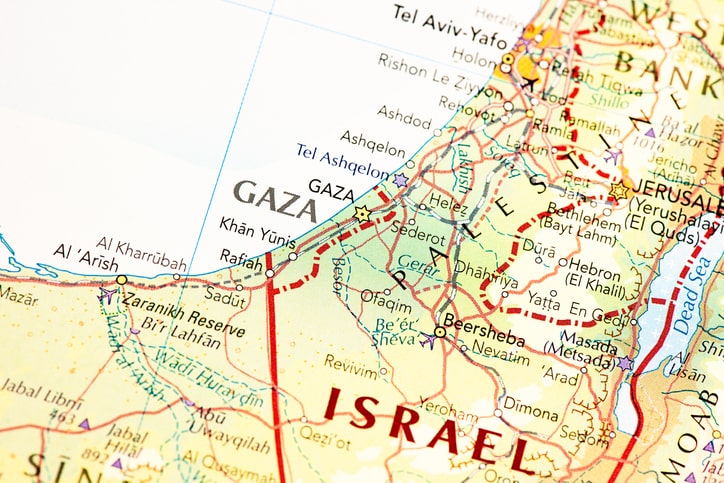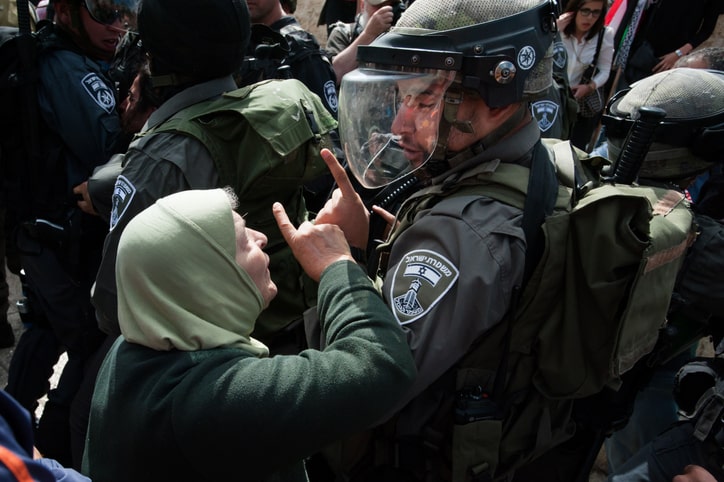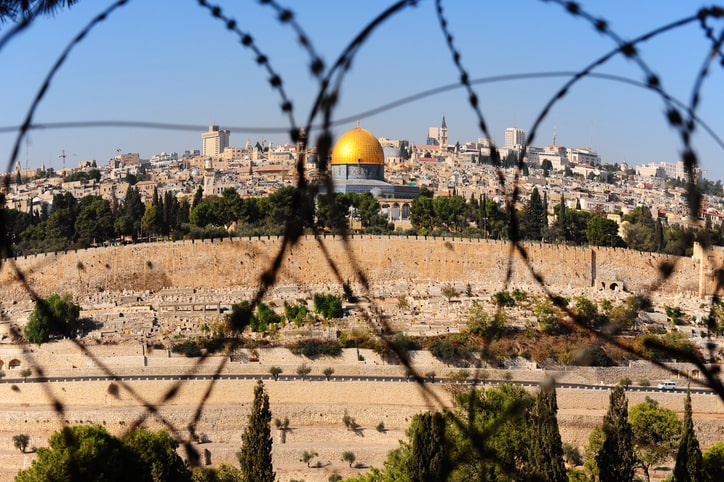Overview: The Israel-Palestine Conflict


The Israeli-Palestinian conflict is an intricate and important situation, as well as a saga that has captivated the attention of the international community for decades. In this tale of historical complexities, political tensions, and human aspirations, we embark on a journey to explore the hopes, challenges, and potential paths towards a brighter future — particularly after recent conflicts escalated in October of 2023.
As we delve into the background and events that have shaped this enduring struggle, let’s uncover the seeds of understanding, dialogue, and peacebuilding that hold the promise of a more harmonious coexistence between Israelis and Palestinians. And as any exploration of this situation also comes with a wide array of terminology and organizations, we have compiled a Glossary of Israeli-Palestinian Conflict Related Terms to help.
Note: The Israel-Palestine conflict remains one of the world's most enduring and contentious disputes. Understanding it requires an open mind, in-depth knowledge of history, and a balanced perspective on the narratives of both sides. It's our purpose to explore it in an unbiased manner, whether on Infoplease, with family and friends, or when discussing the conflict online!
Israel and Palestine Conflict: A Historical Background
The roots of the Israeli-Palestinian conflict can be traced back to the early 20th century. Various historical milestones and significant occurrences have further deepened the complexities of this conflict, fueling tensions and creating a challenging path toward resolution.[1]
It is crucial to explore the intricate web of historical, social, and geopolitical factors that have contributed to the ongoing Israeli-Palestinian conflict in order to gain a comprehensive understanding of its complexities and potential avenues for peacebuilding.
-
The Balfour Declaration: In 1917, the British government expressed support for the establishment of a "national home for the Jewish people" in Palestine. This declaration fueled Jewish aspirations for a homeland in Palestine.
-
British Mandate for Palestine: After World War I, the League of Nations granted Britain a mandate to administer Palestine. The British mandate further fueled tensions between Jewish and Arab communities as both sought self-determination and control over the land.
-
Zionist Movement: The Zionist movement, led by figures like Theodor Herzl, sought to establish a Jewish homeland in Palestine. The movement gained momentum, leading to increased Jewish immigration to the region.
-
The United Nations Partition Plan: In 1947, the United Nations proposed a partition plan for Palestine, recommending the creation of separate Jewish and Arab states. While the plan was accepted by Jewish leaders, Arab leaders rejected it, leading to further tensions and conflicts.
-
1948 Arab-Israeli War: Following the United Nations partition plan for Palestine, the state of Israel was declared in 1948. This led to a war between Israel and neighboring Arab states, resulting in displacement and the creation of Palestinian refugee populations.
-
Six-Day War: In 1967, Israel launched a preemptive strike against Egypt, Syria, and Jordan, resulting in a swift Israeli victory. The aftermath of the war led to the occupation of the West Bank, Gaza Strip, and East Jerusalem by Israel.
-
First Intifada: The First Intifada, also known as the Palestinian uprising, began in 1987 as a series of protests and acts of civil disobedience against Israeli occupation. It played a significant role in shaping the Israeli-Palestinian conflict and drawing international attention to the issue.
-
Oslo Accords: The Oslo Accords, signed in the 1990s, aimed to establish a framework for Israeli-Palestinian peace negotiations. The accords led to the creation of the Palestinian National Authority, a self-governing body for Palestinians in parts of the West Bank and Gaza Strip.
-
Second Intifada: The Second Intifada, also known as the Al-Aqsa Intifada, began in 2000 and was characterized by a wave of Palestinian uprisings against Israeli occupation. The violence and unrest during this period had a significant impact on the Israeli-Palestinian conflict.
If you are feeling slightly overwhelmed by the complexities of this entire historical situation, don’t worry — you’re not the only one! Let’s move on and break down some of the most crucial incidents and advances mentioned, and discover how they have influenced the entire course of the disruption between Israel and Palestine.

Israel-Palestine: Major Conflicts
Over the course of the long-standing Israeli-Palestinian conflict, which has been characterized by a complex web of political, social, and historical factors, numerous major conflicts have emerged, each leaving an indelible mark on the region and its inhabitants. These conflicts, which have spanned several decades, have not only shaped the political landscape of the region but have also had far-reaching consequences for the lives of countless individuals on both sides of the conflict.
The Six-Day War
In 1967, tensions between Israel and its neighboring Arab states had escalated to a point where a breaking point seemed imminent.[2] In response, Israel decided to launch a preemptive strike against Egypt, Syria, and Jordan. This decisive action by Israel proved to be highly successful, resulting in a swift victory.
However, the outcomes of this important win had extensive effects. Due to the war, Israel found itself in a situation where it had to take control and govern the areas of the West Bank, Gaza Strip, and East Jerusalem. This occupation had significant consequences not just for Israel, but also for the residents of these territories, as it fundamentally altered the geopolitical situation of the region.
Yom Kippur War
In the year 1973, a significant event took place when Egypt and Syria unexpectedly initiated an attack on Israel, coinciding with the observance of the Yom Kippur holiday. This military confrontation resulted in a fierce and protracted battle, causing substantial casualties for both the attacking and defending forces. The intensity of the fighting was so profound that it left a lasting impression on the region. Eventually, a ceasefire was brokered by the United Nations, marking a momentary halt to the hostilities.
Second Intifada
The Second Intifada, also known as the Al-Aqsa Intifada, began in 2000 and was characterized by a wave of Palestinian uprisings against Israeli occupation. The violence and unrest during this period had a significant impact on the Israeli-Palestinian conflict, resulting in a high number of casualties and further escalating tensions between the two sides.
Civilian Impact: What Happens to the People?
The Israeli-Palestinian conflict is a highly controversial and deeply divisive issue that has had profound effects on civilians living in the region. The conflict has resulted in significant human suffering, loss of life, displacement, and economic hardships for both Israelis and Palestinians.
Violence, Human Rights, and Mental Health
One of the main issues surrounding the conflict is the ongoing cycle of violence and retaliation. Acts of violence, such as bombings, shootings, and rocket attacks, have resulted in civilian casualties on both sides.[3] This has created a climate of fear and insecurity for civilians, who often find themselves caught in the middle.
The conflict has also had a negative impact on the daily lives of civilians. Movement restrictions, checkpoints, and barriers have made it challenging for Palestinians to access essential services, such as healthcare and education. Palestinians in the West Bank and Gaza Strip face significant difficulties in terms of freedom of movement, economic opportunities, and access to resources – all of which cause detrimental impacts on regional human rights, according to Amnesty International.[4]
Furthermore, the construction of Israeli settlements in the occupied territories has been a major point of contention. These settlements are considered illegal under international law and have led to Palestinians being forced from their homes and land. This has resulted in a loss of livelihood, increased poverty, and limited access to natural resources for Palestinian communities.
The Israeli-Palestinian conflict has also had a profound psychological impact on civilians. The constant threat of violence, the loss of loved ones, and the experience of living under occupation have contributed to high levels of stress, trauma, and mental health issues among both Israelis and Palestinians.
What Can Be Done?
It is important to note that the impact of the conflict on civilians is not limited to those directly involved. The cycle of violence and instability in the region has had broader regional and global implications. The conflict has strained international relations, fueled extremism, and hindered efforts for peace and stability in the Middle East and the world, leading to a global impact that has spurred peace attempts.
Efforts to address the controversy and mitigate the impact on civilians have been ongoing. International organizations, governments, and humanitarian agencies have provided aid, support, and advocacy for civilians affected by the conflict. Additionally, peace negotiations, diplomatic initiatives, and grassroots movements continue to work towards finding a just and lasting solution to the Israeli-Palestinian conflict, with benefits for both sides, and the entire world.[5]

Israel-Palestine Conflict: Peace Efforts
Despite the ongoing conflict, numerous peace efforts have been made to resolve the Israeli-Palestinian dispute, including the following important advances:
Camp David Accords
In 1978, Israel and Egypt signed the Camp David Accords, a historic peace treaty brokered by former U.S. President Jimmy Carter. The treaty resulted in Israel's withdrawal from the Sinai Peninsula and the establishment of diplomatic relations between the two countries.
Oslo Accords
The Oslo Accords, signed in the 1990s, aimed to establish a framework for Israeli-Palestinian peace negotiations. The accords led to the creation of the Palestinian National Authority, a self-governing body for Palestinians in parts of the West Bank and Gaza Strip.
Arab Peace Initiative
The Arab Peace Initiative, proposed by the Arab League in 2002, offered a comprehensive peace plan for the Israeli-Palestinian conflict. The initiative called for the recognition of Israel by Arab states in exchange for the establishment of a Palestinian state based on the 1967 borders, with East Jerusalem as its capital. It also addressed the issue of Palestinian refugees and emphasized the need for a just and agreed-upon solution.
Peace to Prosperity
The Peace to Prosperity plan, unveiled by the Trump administration between June 2019 and January 2020, was a proposal aimed at resolving the Israeli-Palestinian conflict and promoting economic development in the region.[6] The plan outlined a vision for a two-state solution, with the establishment of a Palestinian state and the recognition of Israeli sovereignty over existing settlements in the West Bank. It proposed significant economic investments in the Palestinian territories to stimulate growth and improve living conditions.
Palestinian leaders rejected the plan, arguing that it did not adequately address their political aspirations and concerns. Critics raised concerns about the plan's focus on economic development without sufficient attention to core political issues, such as borders, refugees, and the status of Jerusalem. As such, the plan did not gain widespread international support and did not lead to substantial progress in resolving the Israeli-Palestinian conflict.
Abraham Accords
The Abraham Accords were a series of agreements signed in 2020 between Israel and several Arab states, including the United Arab Emirates, Bahrain, Sudan, and Morocco. These agreements aimed to normalize diplomatic, economic, and cultural relations between Israel and these Arab nations, potentially opening up new avenues for cooperation and peace in the region, and were another attempt at mediation between Israel and Palestine.
Israel-Palestine Conflict: Key Players
Throughout the course of the Israeli-Palestinian conflict, numerous influential individuals have emerged, each playing a crucial part in shaping the ongoing struggle for peace and justice in the region. It is important to acknowledge and recognize the contributions of these key figures, as their actions and decisions have had a profound impact on the course of history in the Middle East. The following names include just some of these players in the region and around the world.
-
Benjamin Netanyahu: Benjamin Netanyahu has served as the Prime Minister of Israel for multiple terms. Known for his conservative stance on security issues, he has advocated for Israeli security and a cautious approach to peace negotiations.
-
Mahmoud Abbas: Mahmoud Abbas has been the President of the Palestinian National Authority since 2005. He has been a vocal advocate for the recognition of Palestinian statehood and an end to Israeli occupation.
-
Ayatollah Ali Khamenei: Ayatollah Ali Khamenei is the Supreme Leader of Iran and has been a vocal supporter of the Palestinian cause. He has consistently criticized Israel and called for its elimination, supporting Palestinian resistance against Israeli occupation.
-
Ismail Haniyeh: Ismail Haniyeh is a senior political leader of Hamas, a Palestinian political and military organization. He has played a significant role in shaping Hamas' policies and has been involved in negotiations and conflicts with Israel.
-
Jared Kushner: Jared Kushner is an American businessman and previous senior advisor to former President Donald Trump. He played a key role in the Trump administration's efforts to broker peace in the Israeli-Palestinian conflict, including the unveiling of the "Peace to Prosperity" plan.
-
Joe Biden: Joe Biden is the current President of the United States. As a key player in international diplomacy, he has expressed support for a two-state solution to the Israeli-Palestinian conflict and has been involved in diplomatic efforts to promote peace in the region.

Israel-Palestine Conflict: Ongoing Issues
The Israeli-Palestinian conflict is very complicated and involves many ongoing issues that consistently hinder progress toward a resolution. These challenges include disputes over territory, concerns about security, historical grievances, political tensions, and the question of Palestinian statehood.[7] Each of these factors adds complexity to the conflict, making it hard to find a complete and lasting solution that satisfies all parties involved.
Israeli Settlements
Israeli settlements in the West Bank have been a major point of contention. These settlements, considered illegal under international law, are seen as an obstacle to peace negotiations. The expansion of Israeli settlements into Palestinian territories has resulted in the displacement of Palestinians and has further complicated the issue of land ownership and sovereignty.
Status of Jerusalem
The status of Jerusalem is a highly sensitive and disputed issue. Both Israelis and Palestinians claim Jerusalem as their capital, leading to ongoing tensions and disagreements. The city holds deep religious and historical significance for both sides, making it a focal point of contention in negotiations and a major obstacle to peace.
Right of Return
The Right of Return is a key demand for Palestinian refugees who were displaced during the establishment of Israel. This issue remains a major obstacle in peace negotiations. Palestinians argue that refugees and their descendants should have the right to return to their original homes and properties, while Israel maintains that such a return would threaten its status as a Jewish state.
Security Concerns
Security concerns play a significant role in the Israeli-Palestinian conflict. Both Israelis and Palestinians have legitimate concerns about their safety and the protection of their communities. Incidents of violence, attacks, and terrorism have fueled mistrust and made it challenging to establish a lasting peace.
Water Resources
Water scarcity and access to water resources are contentious issues in the Israeli-Palestinian conflict. The control and allocation of water sources, such as the Jordan River and underground aquifers, have been a source of tension. Palestinians argue that they are not given an equitable share of water resources, leading to hardships and limited access to clean water for Palestinian communities.
Modern-Day Issues
Even today, issues like the Israeli West Bank barrier, the Hamas-Fatah conflict, violent events through the years, and the status of Jerusalem remain contentious. The Right of Return for Palestinian refugees, the Israeli settlements, and the one-state versus two-state solution debates also continue to cause discord. Israeli defense systems like the Iron Dome and groups like Hezbollah further complicate the situation.
Israel-Palestine Conflict: Potential Solutions
Various potential solutions have been proposed to resolve the Israeli-Palestinian conflict, but none have yet been successful. It is important to note that while there is no shortage of potential solutions, finding a viable and mutually acceptable resolution to the Israeli-Palestinian conflict remains a complex and challenging task.
-
Two-State Solution: This solution suggests the establishment of separate independent states for Israelis and Palestinians, with defined borders and mutually agreed-upon arrangements for security and governance. However, this solution might be one of the more difficult options, researchers fear.[8]
-
One-State Solution: Some proponents argue for a single, binational state where Israelis and Palestinians would have equal rights and representation. However, this solution faces significant challenges and is not widely supported.[9]
-
Confederation or Regional Framework: There have also been proposals for a confederation or regional framework that promotes cooperation and shared governance between Israelis and Palestinians.
-
Regional Peace Initiatives: Regional peace initiatives involving multiple countries have also been proposed as potential solutions to the Israeli-Palestinian conflict. These initiatives aim to foster cooperation, dialogue, and peaceful relations between Israel and its neighboring Arab states. They seek to address broader regional dynamics and promote stability and prosperity for all parties involved.
-
Mediation and Diplomatic Actions: International mediation and diplomacy have played a significant role in peace negotiations between Israelis and Palestinians. The involvement of third-party mediators, such as the United Nations, the United States, and other international actors, has been crucial in bridging gaps, facilitating dialogue, and encouraging compromises.

Current Events in the Israeli-Palestinian Conflict
Most recently, on October 7, 2023, the struggle between Israel and Palestine was renewed when Hamas launched an attack on Israeli territory from the Gaza Strip.[10]
Hamas, an important military movement that is not only Islamist but also political, launched an incursion into primarily southern Israeli territory.[11] This was one of the first Palestinian-led attacks in recent times, titled Operation Al-Aqsa Flood, and also included thousands of rockets.
Israel’s troops were quick to muster their forces and address the Palestinian attack, but sadly, Israeli civilians and soldiers alike had already lost their lives or been taken hostage. However, as Israel began to push back against Hamas, Palestinian civilians were also targeted as the conflict heightened and tensions surpassed even an explosive level, including intensive airstrikes against Gaza. These airstrikes have been described as the worst in years, and carried out at an “unprecedented scale”.[12]
This is just another entry in the historical timeline of conflict between Israel and Palestine, which not only affects the political, geopolitical, and religious aspects of the area, but also has claimed hundreds — if not thousands — of lives in just a few days. As such, leaders around the world renewed efforts to support peace in the region and bring a stop to the violence once and for all.
Summing Up the Israel and Palestine Conflict
The Israeli-Palestinian conflict is undeniably a complex and deeply rooted issue with a lengthy history of disputes, conflicts, and unsuccessful peace efforts. The ongoing tensions, unresolved key issues, and differing narratives unquestionably present challenges in finding a lasting solution.
Nevertheless, the exploration of potential peace through either a two-state or one-state solution persists, with unwavering international efforts dedicated to seeking a resolution. As the world observes, the relentless pursuit of peace and mutual understanding remains absolutely vital for the future well-being of both Israelis and Palestinians.
If you want to keep up with news around the world, including the Israel-Palestine conflict, peruse our collection of Current Events, updated weekly, every Friday. You can also test your knowledge of this region with our Middle Eastern Geography Quiz, How Well Do You Know Palestine Quiz, or Israel Map Quiz!
People Also Ask…
This conflict is a complex issue plaguing not only the involved parties in the Middle East, such as Israel and Palestine, but also the entire world. As such, you might have some more questions, so we have compiled answers to some of the most common queries about the Israel Palestine conflict.
What Is the Israel Palestine Conflict About?
The Israeli-Palestinian conflict was caused by competing nationalisms and the struggle for land between Israelis and Palestinians. Historical disputes over territory, self-determination, and competing claims to Jerusalem have fueled tensions and conflicts
Who Are the Key Figures in the Israel Palestine Conflict?
Key figures include political leaders like Benjamin Netanyahu and Mahmoud Abbas. Organizations like the PLO, Hamas, and the Arab League are also significant players.
What is the Status of Jerusalem in the Israel Palestine Conflict?
Jerusalem's status remains a contentious issue. Both Israelis and Palestinians claim it as their capital, but many countries don’t officially recognize these claims.
What Is the Two-State Solution?
The Two-State Solution proposes independent Israeli and Palestinian states co-existing side by side. It's seen by many as the most feasible solution to the conflict.
What Is the Right of Return?
The Right of Return refers to the principle that Palestinian refugees, displaced during the 1948 Arab-Israeli war and subsequent events, should be allowed to return to their homes.
About the author









